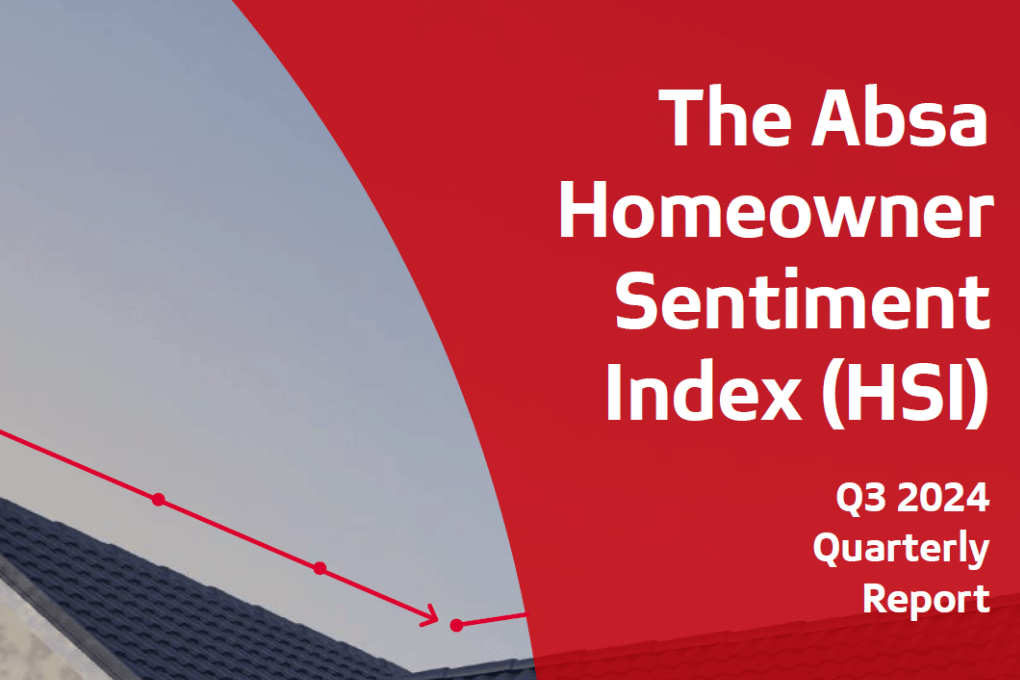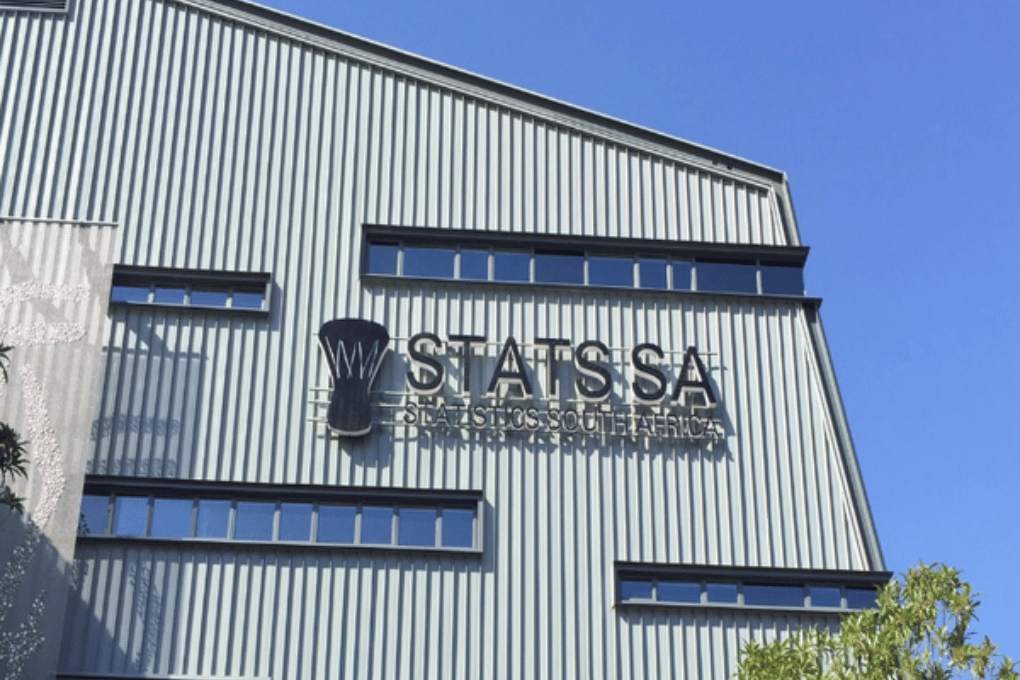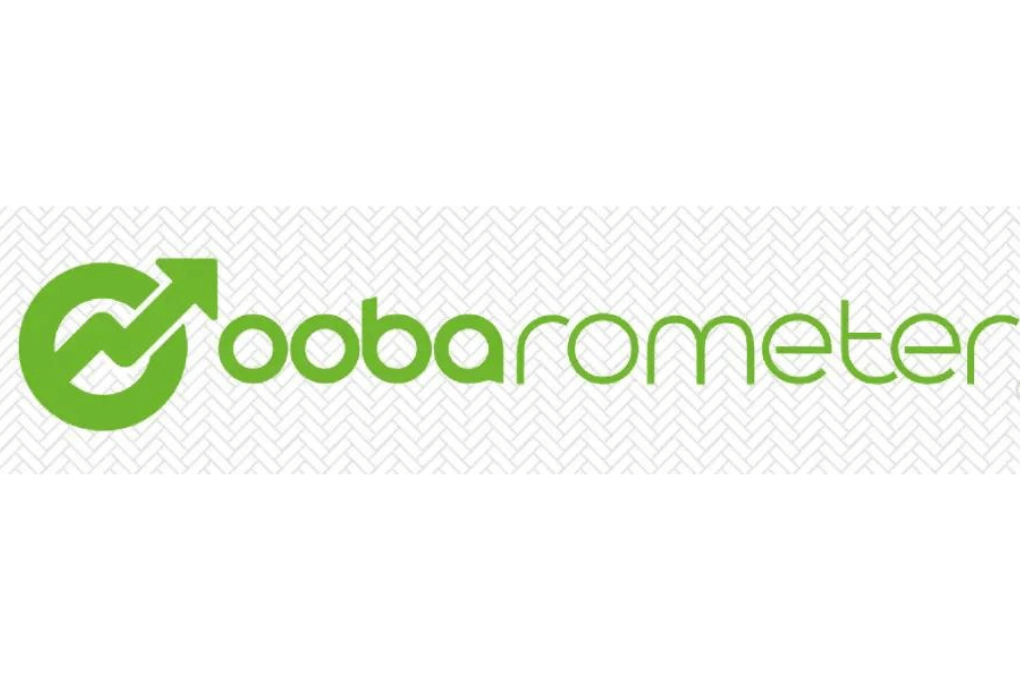

ABSA Homeowner Sentiment Index - Q3 2024
The Q3 2024 Absa Homeowner Sentiment Index (HSI) reveals cautious optimism in South Africa’s residential property market, with 84% expressing confidence. Buyer sentiment rose to 73%, while first-time buyers lead demand. Interest rate cuts and improving house price indices support recovery, though strained short-term finances temper immediate benefits.





















BetterBond Property Brief - August 24


StatsSA Residential Property Price Index - March 2024 (issued August)
Residential property prices in South Africa are on an upward trend, with the national Residential Property Price Index (RPPI) rising by 3.5% in the 12 months to March 2024, up from 3.1% in February. Western Cape saw the sharpest rise at 7.7%, while Northern Cape and Limpopo experienced declines. Metropolitan areas saw a 2.6% annual increase, with Buffalo City leading at 7.0%. Prices in Johannesburg fell by 1.3%. Over five years, property prices rose by 23.8% nationally, with Western Cape showing the highest growth at 35.5%. Gauteng’s growth lagged at 16.4%.



oobarometer - Q2 24
The Q2 2024 oobarometer shows cautious optimism in South Africa’s residential property market, with promising trends emerging among younger homebuyers. While high interest rates have slowed activity, predictions of rate cuts and political stability under the new Government of National Unity are expected to aid recovery. Property prices have seen slight growth, though inflation keeps real growth negative. First-time homebuyer demand remains subdued, but younger buyers (18-25) are investing more, leveraging property as a wealth-building tool. Buy-to-let investments have also surged, particularly in the Western Cape. Banks continue offering competitive rates, maintaining strong approval rates and aiding market resilience.










BetterBond Property Brief - July 24
The July Property Brief reflects optimism following South Africa’s national elections. Although new home loan activity stalled in the second quarter due to uncertainty, global and local markets responded well to the election outcome. The Government of National Unity’s commitment to protecting private property rights signals potential recovery in the residential property market. With hopes of easing lending rates and a strong rand, economic growth seems within reach. Dr. Roelof Botha highlights how the new government can bolster business confidence, with expectations for the Reserve Bank to end restrictive monetary policies and support further market stability.







FNB Property Barometer - June 2024
The FNB House Price Index saw a slight rise to 0.5% year-on-year in June, up from 0.3% in May. Slower house price growth reflects high living and borrowing costs, with better performance in lower-priced and non-metro areas. Indicators suggest potential stabilization in supply and demand, and a cautiously optimistic outlook is maintained. Interest rate cuts and pro-growth policies under the new administration could revitalize the housing market by boosting buyer activity.










BetterBond Property Brief - June 24
This edition of the Property Brief coincides with South Africans reflecting on the national election results and the Reserve Bank’s decision to maintain the interest rate. Despite concerns of election-induced instability, BetterBond reported a 4.2% quarter-on-quarter increase in new home loan applications, indicating some stability in the residential property market. Although year-on-year growth was subdued, the ongoing decline in the consumer price index (CPI) raises hopes for future interest rate cuts. Dr. Roelof Botha notes the economy’s progress, citing marginal GDP growth, no recent load shedding, and global recognition for conference hosting, while advocating for less restrictive monetary policy.
ABSA Homeowner Sentiment Index - Q2 2024
In 2024, homeownership trends highlight several key developments. Solo female homeowners, particularly young, black women in South Africa, are becoming significant drivers in the property market. Renting properties for secondary income, especially short-term rentals, is also on the rise, while renters appreciate the flexibility and affordability. There is a growing interest in sustainable homes, with eco-consciousness influencing buying decisions. However, going completely off-grid is less of a priority, likely due to recent improvements in energy supply.










BetterBond Property Brief - May 24
This month’s data shows slight but positive growth in South Africa’s property market. The national average home loan value rose by 1.2% to R1.25 million, and the number of home loans granted in April 2024 increased by 20% compared to a year ago, signaling the market has stabilized after a two-year slowdown. Hopes for further growth rest on a potential decline in interest rates, driven by a falling consumer price index (CPI) and food prices. Dr. Roelof Botha highlights the burden of high debt costs due to restrictive monetary policy, which has constrained market activity.







FNB Property Barometer - Apr 2024
The FNB House Price Index growth averaged 0.6% y/y in April, slightly lower than
the 0.7% in March. Market strength indicators, derived from the property
values database, suggests both buyer demand and seller supply are shrinking . High borrowing costs and uncertainty are discouraging potential buyers, while
unfavourable selling conditions are disincentivising some homeowners from listing
their properties.










BetterBond Property Brief - April 24
This issue presents a cautiously optimistic view of South Africa’s property market. Despite the high prime overdraft rate of 11.75% and an 8% year-on-year decline in BetterBond home loan applications, there was a 7.8% quarter-on-quarter increase in early 2024, signaling the market may be bottoming out. Hopes are pinned on a potential interest rate drop at the upcoming Monetary Policy Committee meeting. Economist Dr. Roelof Botha highlights the downward trend in food prices and the rising gold price, which may strengthen the rand, reduce inflation, and eventually lower interest rates.



oobarometer - Q1 24
Despite the high interest rate environment, ooba Home Loans’ Q1 2024 statistics indicate signs of recovery in South Africa’s property market. Home loan applications were down 9% year-on-year but rose 8% quarter-on-quarter, showing increased activity. Property prices grew 3.1% year-on-year, driven by affluent buyers, while buy-to-let investments climbed to 13% of applications. First-time homebuyers remain cautious, with activity contracting by 3%, though more are saving for deposits. Bank approval rates remain stable at 83.4%, and lenders continue offering competitive rates. With expected interest rate cuts later in 2024, the property market is poised for gradual growth.










BetterBond Property Brief - March 24
New home loan activity has started the first quarter of 2024 on an improved
note, with a QOQ increase of 7.8% in the number of home loan applications
submitted (figure 1). Unfortunately, high interest rates continue to impact
negatively on the residential property market, with the YOY increase still down
by 8%. With the Q1 2024 level on par with Q2 2023, it does suggest a measure of
new-found stability in the residential property market, probably influenced by
lower inflation and speculation that interest rates may start declining soon.


ABSA Homeowner Sentiment Index - Q1 2024
In Q1 2024 we surveyed 1 149 consumers about the SA property market. When asked whether they “are currently confident about the property market in SA (by this thinking it is a secure asset that will create sufficient wealth over the longer term)”, positive responses amounted to 82%, which was 4% higher than in Q4 2023. This is a positive sign that although the general environment is still strained, the sentiment around property in the future is starting to look more promising.







FNB Property Barometer - Q1 2024
A sideways movement in house prices, outlook slightly dimmer.
The FNB House Price Index growth averaged 0.8% in 1Q24, unchanged from 4Q23, and echoes our view of a hesitant house price growth trajectory in the near term. The elevated living and borrowing costs, as well as heightened political uncertainty both domestically and internationally, are weighing on transaction activity, and ultimately, property prices. Nevertheless, wide disparities are evident across regions. Generally, larger non-metro regions are seeing stronger house price growth relative to the traditional metropolitan cities. Demand in these regions gained support from the semi-gration trend.










BetterBond Property Brief - Feb 24
Home loan activity started the year on a solid footing, with January applications
virtually at the same level as the Q4 2023 monthly average (figure 1). This is
encouraging as January is usually quite a slow month for many businesses,
following on from the summer holiday season.
There is nevertheless cause for some concern that, since Q4 2021, home loan
applications have been below levels achieved in the last quarter before
the Covid-19 pandemic. Unsurprisingly, this downward trend started in the
same quarter as the Reserve Bank Monetary Policy Committee commenced
interest-rate hikes.







FNB Property Barometer - Feb 2024
Interest rates are expected to have reached their peak, with reductions anticipated in late 2024, potentially boosting property demand and prices in the second half of the year. This outlook is supported by projections of lower interest rates, improved growth, and continued job gains. However, there are inflation-related risks that could maintain higher borrowing costs, delaying the anticipated housing market recovery. Early 2024 shows positive housing market trends, but their sustainability remains uncertain.







FNB Property Barometer - Dec 2023
We expect that interest rates have reached their peak, with a measured cutting cycle coming into view in the latter half of 2024. Nevertheless, persistent risks including heightened geopolitical and adverse weather patterns complicate the deceleration trend in inflation and could prolong the lift in inflation expectations away from target. This could cause interest rates to remain high for longer than we currently anticipate, and market weakness would be protracted. Positively, surveyed data suggests that home buying activity is levelling out, while our house price index growth is now showing signs of a mild recovery from depressed levels. Our projections of slightly lower interest rates, moderately better growth outcomes and continued employment gains should help support a modest lift in demand for property, and consequently property prices from 2H24







FNB Property Barometer - Nov 2023
Interest rates are expected to have peaked, with a likelihood of reductions in the second half of 2024. Buying activity has decreased due to reduced affordability, remaining below pre-pandemic levels, though lower-priced markets see some support from downscaling trends. Young buyers, particularly affected by economic slowdown and high interest rates, show increased pessimism. Projections suggest a minor decrease in interest rates and a moderate improvement in economic growth could stabilize mortgage volumes and property price growth in the upcoming year.
